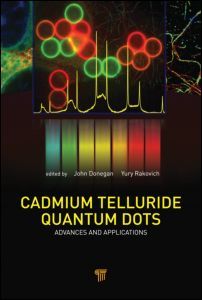Description
Cadmium Telluride Quantum Dots
Advances and Applications
Coordinators: Donegan John, Rakovich Yury
Language: English
Subjects for Cadmium Telluride Quantum Dots:
Keywords
CdTe NCs; CdTe QD; Optical Properties of Bulk and Nanocrystalline Cadmium Telluride; American Chemical Society; Assemblies of Thiol-Capped CdTe Nanocrystals; Zinc Blende; Aqueous Synthesis of Colloidal CdTe Nanocrystals; Resonant Energy Transfer; Emission of CdTe Nanocrystals Coupled to Microcavities; QDs; Biocompatibility and Cellular Localisation of CdTe Quantum Dots; DNA Hybridization Assay; ZnS QDs; DNA Duplex; CdTe QDs; QD Concentration; PL Spectrum; WGM Resonance; Aqueous Synthesis; Biocompatible QDs; QD Molecule; Donor Acceptor Separation; DNA Probe; DNA Duplex Form; CdSe QDs; QD Monolayer; Initial Feed Ratio; PL Lifetime; Non-complementary DNA; QDs Fluorescence
· 15.2x22.9 cm · Hardback
Description
/li>Contents
/li>Biography
/li>
In the last two decades, semiconductor quantum dots?small colloidal nanoparticles?have garnered a great deal of scientific interest because of their unique properties. Among nanomaterials, CdTe holds special technological importance as the only known II?VI material that can form conventional p?n junctions. This makes CdTe very important for the development of novel optoelectronic devices such as light-emitting diodes, solar cells, and lasers. Moreover, the demand for water-compatible light emitters and the most common biological buffers give CdTe quantum dots fields a veritable edge in biolabeling and bioimaging.
Cadmium Telluride Quantum Dots: Advances and Applications focuses on CdTe quantum dots and addresses their synthesis, assembly, optical properties, and applications in biology and medicine. It makes for a very informative reading for anyone involved in nanotechnology and will also benefit those scientists who are looking for a comprehensive account on the current state of quantum dot?related research.
Optical Properties of Bulk and Nanocrystalline Cadmium Telluride. Aqueous Synthesis of Colloidal CdTe Nanocrystals. Assemblies of Thiol-Capped CdTe Nanocrystals. Förster Resonant Energy Transfer in CdTe Nanocrystal Quantum Dot Structures. Emission of CdTe Nanocrystals Coupled to Microcavities. Biological Applications of Cadmium Telluride Semiconductor Quantum Dots. Biocompatibility and Cellular Localisation of CdTe Quantum Dots.
Yury Rakovich received his diploma in physics from Belarusian State University, Belarus, and PhD in physics from the National Academy of Sciences of Belarus, Belarus, in 1995. He worked as a lecturer and associate professor in physics at the Brest State Technical University, Belarus, until 1997 and moved to the University of Minho, Portugal, in 1998. He joined the School of Physics at Trinity College Dublin in 2001, where he worked as a senior research fellow at the Centre for Research on Adaptive Nanostructures and Nanodevices (CRANN). Since 2010, he has been an Ikerbasque research professor leading the experimental nanophotonics group at Materials Physics Center, San Sebasian, Spain. He is also a part-time professor at the University of the Basque Country. Dr. Rakovich’s current research focuses on optics of microcavities and photonic molecules, nanophotonics, semiconductor nanocrystals, organic nanomaterials, and plasmonics.
John F. Donegan received his BSc and PhD from the National University of Ireland, Galway. He had postdoctoral periods at Lehigh University and the Max Planck Institute for Solid State Research, Stuttgart. He was appointed to the academic staff in Trinity College Dublin in 1993. He leads the Semiconductor Photonics Group and is also a principal investigator at the CRANN research institute in Trinity College Dublin. His research is in the area of photonics, in particular the interaction of light with photonic structures: microspheres and photonic molecules coupled with nanocrystal emission, tunable laser structures based on slotted lasers, and two-photon absorption microcavity structures.
These books may interest you

Quantum Dots for DNA Biosensing 52.74 €



